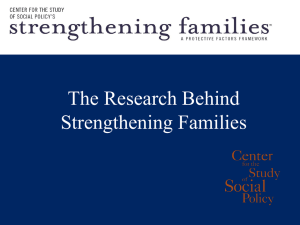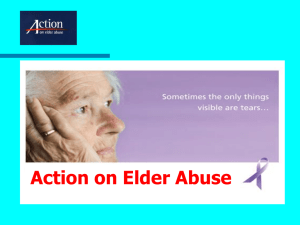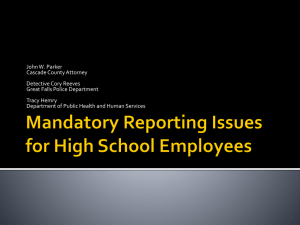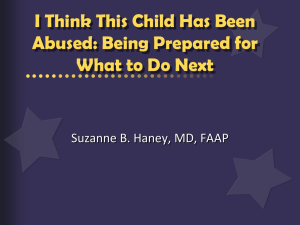113C - American Bar Association
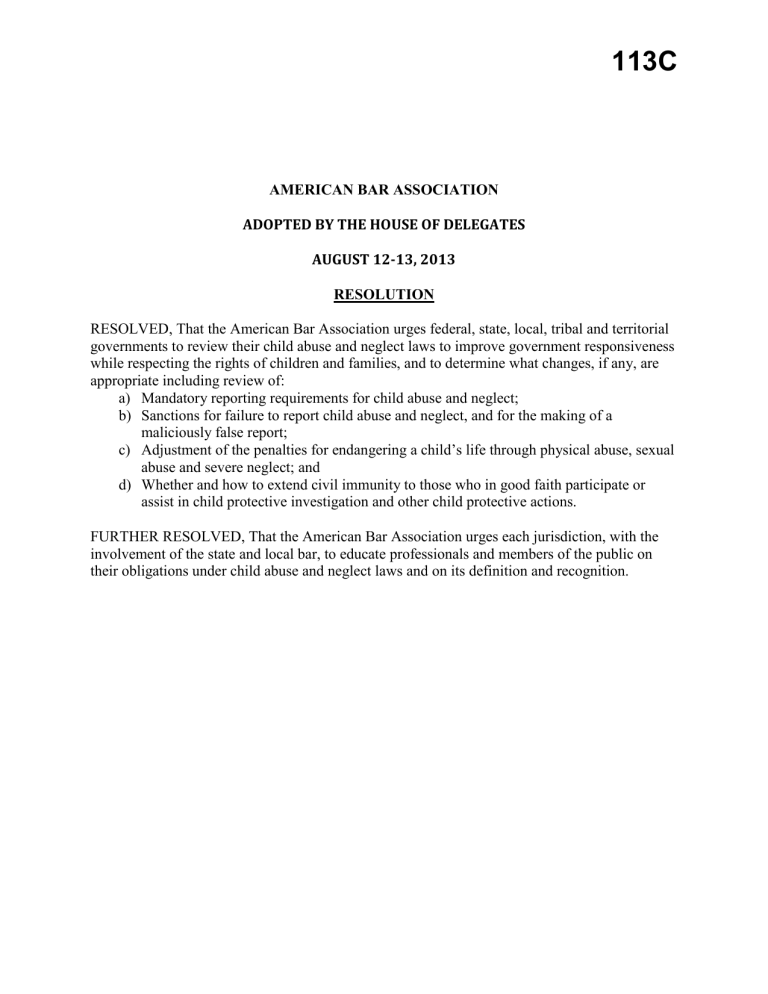
113C
AMERICAN BAR ASSOCIATION
ADOPTED BY THE HOUSE OF DELEGATES
AUGUST 12-13, 2013
RESOLUTION
RESOLVED, That the American Bar Association urges federal, state, local, tribal and territorial governments to review their child abuse and neglect laws to improve government responsiveness while respecting the rights of children and families, and to determine what changes, if any, are appropriate including review of: a) Mandatory reporting requirements for child abuse and neglect; b) Sanctions for failure to report child abuse and neglect, and for the making of a maliciously false report; c) Adjustment of the penalties for endangering a child’s life through physical abuse, sexual abuse and severe neglect; and d) Whether and how to extend civil immunity to those who in good faith participate or assist in child protective investigation and other child protective actions.
FURTHER RESOLVED, That the American Bar Association urges each jurisdiction, with the involvement of the state and local bar, to educate professionals and members of the public on their obligations under child abuse and neglect laws and on its definition and recognition.
113C
REPORT
Child abuse and neglect are problems that affect all income levels, races, and ethnic groups. Nearly five children die each day in the United States as a result of abuse and neglect by those entrusted with their care.
1
Approximately 42 percent of those who die from abuse are infants under age one, while children younger than four account for over 81 percent of these fatalities.
2 In 2011, child protective services (CPS) agencies received an estimated 3.4 million referrals of alleged abuse and neglect involving approximately 6.2 million children.
3
More than 61,000 children were confirmed as victims of sexual abuse in 2011.
4
In the same year, sexual abuse of children accounted for 9.1 percent of the nearly 681,000 substantiated cases of child abuse and neglect.
5
The following are additional statistics concerning sexual abuse of children:
In cases where victims are under age 12, the offender is most often a family member or acquaintance, and seldom a stranger.
6
1 in 3 girls and 1 in 7 boys will be sexually assaulted before they reach age 18.
7
47% of all juvenile sexual assault victims were under age 12.
8
Recent high-profile cases concerning child abuse and neglect demonstrate the need to review mandatory reporting laws for instances of child abuse or neglect to determine what changes, if any, are appropriate to better protect children. Furthermore, states should review their sanctions for both failure to report child abuse and neglect, and for making maliciously false reports. Changes in these laws could promote an increase in accurate reporting. Also, states should determine whether adjusting penalties for endangering a child’s life though physical or sexual abuse or severe neglect would limit incidents of abuse and neglect. States should also examine whether and how to extend civil immunity to those who in good faith participate or assist in child protective investigations and other child protective activities. If providing immunity ensures the safety of children suffering from abuse and neglect, this could be an appropriate step. Finally, states should better educate professionals and the public on the definitions of abuse and neglect and their obligations under state statutes. By reviewing these laws and, where appropriate, making changes governments can ensure that children are adequately protected and that the reporting of child abuse incidents results in appropriate measures being taken to protect the most vulnerable members of society.
1 U.S. Dep’t of Health & Human Services, Child Maltreatment 2011, available at http://www.acf.hhs.gov/programs/cb/resource/child-maltreatment-2011.
2 Id.
.
3 Id.
4 Id.
5 Id.
6 See Howard Snyder & Melissa Sickmund, Juvenile Offenders and Victims: 2006 National Report , National Center for Juvenile Justice (2006)..
7 Stop it Now!. How Often are Children Sexually Abused , available at http://www.stopitnow.org/csa_fact_prevalence1.
8 Howard Snyder & Melissa Sickmund, Juvenile Offenders and Victims: 2006 National Report , National Center for
Juvenile Justice (2006)..
1
113C
Differences in Reporting Statutes across the States
The Child Abuse Prevention and Treatment Act (CAPTA), (42 U.S.C. § 5101) identifies a set of behaviors that define child abuse and neglect.
9
However, each state has its own definitions of child abuse and neglect that are based on standards set by federal law.
10
All 50 states, the District of Columbia, and U.S. Territories have mandatory child abuse and neglect reporting laws that require certain professionals and institutions to report suspected maltreatment to a child protective services (CPS) agency.
11
Mandated reporting laws for abuse and neglect have led to an increase in the number of cases of suspected child abuse reported and investigated each year. Between 1995 and 2011, reports of suspected abuse to child protective agencies rose more than 50 percent, from 2 million to 3.4 million referrals per year.
12
Generally, the trend among states has been to expand the categories of people required to report child abuse and to impose harsher penalties on those that fail to report.
13
For example,
Florida has passed the toughest mandatory reporting legislation in the country. It makes failure to report suspected child abuse a felony and fines universities $1 million, along with stripping their state funds for two years if the officials do not report child abuse.
14
Although mandatory reporting statutes are similar across the states, significant variations exist with regard to who must report, the situation under which they must do so, and the procedure through which reporting takes place.
Review of Mandatory Reporting Requirements for Child Abuse and Neglect
Abuse and neglect adversely affect society in a variety of ways; these include significant economic costs resulting from persistent maltreatment of children. The total annual cost of child maltreatment in the United States is estimated at $103.8 billion.
15
This amount includes more than $33 billion in direct expenditures required to serve the needs of abused and neglected children, as well as more than $70 billion of indirect costs related to the long-term effects of child maltreatment on victims, their families, and communities.
16 A 2002 report found that the daily costs to provide child welfare, health care, and mental health services for child abuse and neglect victims, along with funding the criminal justice system processes necessary to hold
9 I U.S. Dep’t of Health & Human Services, Administration on Children, Youth and Families. Child Maltreatment
(2010), available at http://www.acf.hhs.gov/programs/cb/pubs/cm10/cm10.pdf.
10 Id .
11 U.S. Dep’t of Health & Human Services, Administration on Children, Youth and Families. Child Maltreatment
(2010), available at http://www.acf.hhs.gov/programs/cb/pubs/cm10/cm10.pdf.
12 See Reena Kapoor, MD and Howard Zonana, MD, Forensic Evaluations and Mandated Reporting of Child
Abuse , J OURNAL OF THE A MERICAN A CADEMY OF P SYCHIATRY AND THE L AW , Mar. 28, 2013,, http://www.jaapl.org/content/38/1/49.full.
13 See Joann Loviglio, Sandusky Scandal Prompts States to Re-examine Child-abuse Laws , Denver Post (June 10,
2012), http://www.denverpost.com/nationworld/ci_20823016/sandusky-scandal-prompts-states-re-examine-childabuse.
14 Id.
15 Prevent Child Abuse America, Time for reform: Investing in prevention, keeping children safe at
Home , available at http://www.preventchildabuse.org/about_us/press_room.shtml.
16 Id.
2
113C offenders accountable, exceeded $67 million.
17
Medical and mental health care, and special education services, alone are estimated to cost $13 million per day.
18
Some child abuse victims later become involved in committing crimes themselves because their abuse went unreported or they received inadequate treatment and/or counseling.
19
Society spends nearly $176 million daily in the criminal justice system as a result.
20
These costs do not take into account the full extent of human torment these crimes inflict upon their innocent victims. Protection of victims is of the highest priory, however the costs to the public should also be considered. Aside from the other obvious incentives, states have an economic incentive to review their reporting structure.
Multiple states that require all individuals to report cases of child abuse and neglect have articulated their reason as protecting children “whose health and welfare may be adversely affected through injury and neglect.” 21
In order to ensure the state laws are most effectively protecting children, the ABA urges jurisdictions to review their current reporting policies.
Review Sanctions for Failure to Report and Maliciously False Reporting
Jurisdictions should review their current sanctions for failure to report instances of physical or sexual abuse, and neglect. These sanctions are designed to penalize mandatory reporters who fail in their obligation to report. These sanctions must be both an appropriate punishment for their failure to uphold an obligation as well as a significant incentive to encourage disclosure.
Making a false report is recognized as a crime in most jurisdictions, but consideration should be given to whether bad faith reporting should be defined more broadly. Bad faith reports divert resources from legitimate investigations and cause reputational harm to the targets of the reports. In considering the difference between good and bad faith, jurisdictions should examine whether the reporter is providing a complete description of what he or she knows so that the recipient of the report is able to make a judgment as to whether investigation is warranted. The
ABA urges legislatures of all jurisdictions to review their laws regarding failures to report and maliciously false reporting.
Review Civil Immunity
All state laws, and relevant federal law, provide civil immunity for good faith reports of suspected child abuse and neglect. This has helped governments increase the likelihood that abuse and neglect will be reported. However, with appropriate legislative changes, government can provide immunity not only for the initial report of abuse or neglect, but also for many of the actions that a reporter may take following the filing of a report. Thirty-six states offer immunity to reporters that participate in judicial proceedings that may arise.
22
Twenty-six states provide
17 Id.
18 Id.
19 Id.
20 Id.
21 R.I.. Gen. Laws § 40-11-1 (1956).
22 U.S. Dep’t of Health & Human Services, Child Welfare Information Gateway, Immunity for Reporters of Child
Abuse and Neglect (2011), available at http://www.childwelfare.gov/systemwide/laws_policies/statutes/immunity.cfm.
3
113C immunity to a reporter for assisting with or participating in an investigation of allegations of maltreatment.
23
The ABA urges all legislatures to review whether and how to extend civil immunity to those who, in good faith, participate or assist in child protective investigations and other child protective actions.
Review Penalties for Abuse and Neglect
Jurisdictions must examine their current laws to determine whether changes should be made to their penalties for endangering a child’s life through physical abuse, sexual abuse or severe neglect. Penalties for abuse and neglect vary based on jurisdiction and the nature and severity of the offense. These crimes are among the most heinous because of the innocence of the victims. Given the scope of the problem, in 2011 there were 681,000 substantiated cases of abuse and neglect
24
legislatures should review their current laws to determine if the penalties are a sufficient deterrent and to ensure that the punishment is in line with the gravity of the offenses.
Professional and Public Education
Children will be better protected from abuse and neglect if reporting becomes the duty of society as a whole. This requires the public to be adequately educated on what child abuse and neglect are, on how to recognize abuse, and whom to report abuse and neglect to. Currently, mandatory reporting laws vary greatly across jurisdictions. This makes it difficult for the public to understand what the reporting requirements are and what their individual obligations to report are.
Providing training on abuse and neglect to the public would serve a variety of goals.
Increased education and awareness would remedy a lack of knowledge about how to recognize and report suspected cases. Education could prevent misunderstanding and guide individuals to the correct agency to avoid chain of command problems that may hinder official action.
Education could also alleviate the fear of relationship breakdown and repercussions that may follow a report.
As noted above, professionals have duties to report and should be educated on the relationship between reporting requirements, privilege, and confidentiality obligations. The
ABA Model Rules of Professional Conduct allow a lawyer to reveal information relating to the representation of a client to the extent the lawyer reasonably believes necessary to prevent reasonably certain death or substantial bodily harm
25
and allow revelation on the same basis to comply with other laws or court orders.
26 As noted in Comment [6], “paragraph (b)(1) recognizes the overriding value of life and physical integrity and permits disclosure reasonably necessary to prevent reasonably certain death or substantial bodily harm.” 27
The ABA House of
Delegates has consistently rejected proposals to make such disclosures a mandatory obligation of a lawyer under the Model Rules of Professional Conduct. Regulation of lawyers is a function of
23 Id.
24 U.S. Dep’t of Health & Human Services, Child Maltreatment 2011, supra note 40 .
25 M ODEL R ULES OF P ROF
’
L C ONDUCT R. 1.6(b)(1) (2012)..
.
26 Id.
1.6(b)(6)..
27 Id. 1.6, cmt..
4
113C the judicial branch of government and it would likely be a violation of separation of powers to impose a mandatory obligation to reveal information relating to the representation of a client.
Therefore, it would likely be inappropriate for federal, state, local, tribal, or territorial governments to include lawyers in mandatory reporting laws for instances of child abuse or neglect. But consistent with Model Rules 1.6(b)(1) and (6), the ABA encourages lawyers to review any information obtained in the course of the representation of a client to determine whether, under the circumstances, revelation is reasonable.
Conclusion
Because of the importance of this issue and in order to improve government responsiveness while respecting the rights or children and families, the ABA urges governments to take five specific actions. First, jurisdictions should review their mandatory reporting laws to determine what changes, if any, are appropriate to better protect children and to provide appropriate sanctions for abuse and neglect. Second, each jurisdiction should examine its sanctions for failure to report child abuse and neglect, and for the making of a maliciously false report. Third, jurisdictions should determine what, if any adjustment of penalties for endangering a child’s life through physical or sexual abuse, or severe neglect would be appropriate. Fourth, jurisdictions should review whether and how to extend civil immunity to those who, in good faith, participate or assist in child protective investigations and other child protective actions.
Finally, jurisdictions should educate professionals and the public on the definition of child abuse and neglect, how to recognize abuse and neglect, obligations under child abuse and neglect laws, and to whom abuse and neglect should be reported.
Respectfully submitted,
William Shepherd, Chair
Criminal Justice Section
August 2013
5
113C
GENERAL INFORMATION FORM
Submitting Entity: Criminal Justice Section
Submitted By: William Shepherd, Chair
1.
Summary of Resolution(s).
This resolution urges jurisdictions to review their mandatory reporting laws for instances of child abuse or neglect to determine what changes, if any, are appropriate to better protect children and to provide appropriate sanctions for failure to report abuse and neglect. The resolution further urges jurisdictions to educate the public on the definition of child abuse and neglect within the jurisdiction, and how to recognize abuse and to whom to report abuse.
2.
Approval by Submitting Entity.
The proposed resolution was approved by the Criminal Justice Section Council at its May 12,
2013 meeting.
3.
Has this or a similar resolution been submitted to the House or Board previously?
At Midyear 2013 Criminal Justice Section submitted and ultimately withdrew 104B which dealt with substantially similar issues.
4.
What existing Association policies are relevant to this Resolution and how would they be affected by its adoption?
While the ABA has passed resolutions concerning child abuse, it has yet to pass any resolution concerning mandatory reporting laws for victims of child abuse or neglect.
5.
What urgency exists which requires action at this meeting of the House?
This resolution would provide structure to concerned parties to make certain that abuse and neglect does not go unreported. The education provision of the resolution increases awareness about the issue in the jurisdiction.
6.
Status of Legislation. (If applicable)
Not Applicable
7.
Brief explanation regarding plans for implementation of the policy, if adopted by the House of Delegates.
The policy will be distributed to various criminal justice stakeholders in order to encourage and facilitate statutory review. The policy will also be featured on the Criminal Justice
Section website and in Section publications.
8.
Cost to the Association. (Both direct and indirect costs)
No cost to the Association is anticipated.
9.
Disclosure of Interest. (If applicable)
None
6
113C
10.
Referrals.
At the same time this policy resolution is submitted to the ABA Policy Office for inclusion in the 2013 Annual Agenda Book for the House of Delegates, it is being circulated to the chairs and staff directors of the following ABA entities:
Standing Committees
Ethics and Professional Responsibility
Special Committees and Commissions
Center on Children and the Law
Commission on Civic Education in the Nation’s Schools
Commission on Domestic and Sexual Violence
Commission on Lawyer Assistance Programs
Commission on Youth at Risk
Sections, Divisions
Family Law
Health Law
Litigation
Judicial Division
Senior Lawyers Division
State and Local Government Law
Young Lawyers Division
Individual Rights and Responsibilities
11.
Contact Name and Address Information. (Prior to the meeting. Please include name, address, telephone number and e-mail address)
Michael Moore
Beadle County States Attorneys
PO Box 116
Huron, SD 57350-0116
Phone: (605) 353-8430
Fax: (605)353-8434
Email: mmoore@bcsa.us
12.
Contact Name and Address Information. (Who will present the report to the House? Please include name, address, telephone number, cell phone number and e-mail address.)
Stephen A. Saltzburg, Section Delegate
George Washington University Law School
2000 H Street, NW
Washington, DC 20052-0026
Phone: (202) 994-7089; (202) 489-7464
Email: ssaltz@law.gwu.edu
7
113C
Neal R. Sonnett, Section Delegate
2 S. Biscayne Boulevard, Suite 2600
Miami, FL 33131-1819
Phone: (305) 358-2000
Email: nsonnett2@sonnett.com
8
113C
EXECUTIVE SUMMARY
1.
Summary of the Resolution
This resolution urges jurisdictions to review their child abuse and neglect laws to improve government responsiveness while respecting the rights or children and families, and to determine what change, if any, are appropriate including review of 1) mandatory reporting requirements for child abuse and neglect; 2)sanctions for failure to report child abuse and neglect, and for the making of a maliciously false report;
3)Adjustment of the penalties for endangering a child’s life through physical abuse, sexual abuse and severe neglect; and 4) whether and how to extend civil immunity to those who in good faith participate or assist in child protective investigation and other child protective actions.
2.
Summary of the Issue that the Resolution Addresses
Recent high-profile cases demonstrate the need for jurisdictions to review their laws concerning child abuse and neglect. Specifically, states should look at laws addressing mandatory reporting, sanctions, penalties and civil immunity and make changes as necessary.
3.
Please Explain How the Proposed Policy Position will address the issue
This resolution would provide structure to concerned parties to make certain that abuse and neglect does not go unreported. The education provision of the resolution increases awareness about the issue in the jurisdiction.
4.
Summary of Minority Views
None are known.
9


